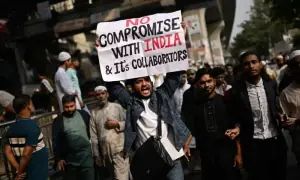Why did she die?
By Neha Khan & Sadia Wali
Sakina has two daughters and two sons aged 7, 5, 3 respectively and the youngest is three months old and nursing. Sakina suddenly learns she is pregnant, as she did not use any method of family planning.
Sakina’s family is financially weak; her husband is the sole earner as a daily wage laborer and their circumstances do not allow them to have another child. Everyone Sakina consults tells her to continue with this pregnancy and use family planning methods for the future.
Sakina gets very upset and tries to abort the pregnancy herself, which causes her a lot of bleeding and miscarriage. Later, when Sakina gets pregnant again within 10 days of her last abortion, she feels embarrassed to tell anyone in the family or the LHW and decides to visit a local traditional birth attendant (Dai), who is not sufficiently trained, to seek Uterine Evacuation (UE) services and this time she dies from the heavy bleeding and complications resulting from unsafe abortion.
Studies show the most common reason for undergoing an abortion is “unintended pregnancy” and unintended pregnancy rates are 45 and 65 per 1,000 women aged 15–44, in developed and developing countries respectively and about 56% of unintended pregnancies result in induced abortions (S. Singh, 2018).
If this critical health issue is analyzed through a regional lens, an estimated 53.8 million unintended pregnancies occur each year and nearly two-thirds (65%) end in abortion. In 2014, specifically in Asia, at least 6-13% of all maternal deaths [5,400 deaths] were due to unsafe abortion(Reproductive Health in Asia, 2021). Further deep dive in to country specific data of Pakistan reveals that, 2.2 million abortions occur, with more than 85% of women accessing services through untrained providers or quacks, resulting in almost 7,00,000 life-threatening complications each year due to the use of outdated and unsafe methods (Guttmacher report, 2009). Unsafe abortions in Pakistan result in several postabortion complications including hemorrhage or excessive bleeding, incomplete abortion, trauma to adjacent anatomical areas or the reproductive tract infections, and sepsis etc. Per local evidence from a national study by Population council [2012], most of Pakistani women undergoing abortions are married and have more than 5 children.
Considering the religious and cultural limitations of the country, abortion in Pakistan is highly stigmatized and considered a taboo topic. Myths, misconceptions, and lack of understanding on the legal aspects are also considered a major impediment in women and girls attempts to avail the services, thus urging them to end up in back street clinics, getting unsafe procedures through untrained providers (Dai) in an unhygienic environment. The fragile health structure of the country is insensitive to such taboo topics – health care providers are often hesitant to provide the abortion services due to faith, religions, and lack of legal insight. Mostly women and girls face societal and family pressure to continue a pregnancy, or some are forced to undergo an abortion through an untrained providers or traditional birth attendants (TBAs/DAI).
Surprisingly, the study of the country abortion law indicates its permissive nature – abortion in Pakistan is allowed to save the life of a woman or to provide “necessary treatment”, which is unknown to many including the service providers, policymakers and particularly the community women and girls as expected. The World Health Organization defines health as not only physical but social and mental wellbeing as well; unfortunately unintended pregnancy and later consequences of unsafe abortion leave behind a significant impact on the women’s mental health and their day-to-day societal relations and survival, even leading to permanent disabilities or death. The flexibility of abortion law allows the service providers to extend abortion services, however in case of any indecision or refusal, providers are bound to refer the clients to other service providers (National guidelines on UE and PAC approved by the Ministry of National Health, Services, Regulations and Coordination, 2018).
Society and governments need to consider that how emotionally and physically painful it is for a woman like Sakina and several others to go through an abortion several times in their lifetime, which ultimately leads to severe complications, even death. Several actors are involved in pushing such women and girls to this vicious cycle of repeated abortions and unsafe procedures. A close observation of the situation uncovers, that the service providers are the first focal point to which a woman prefers and trusts to reach out after taking the decision of going through an abortion. However, the service providers are mostly scared, hesitant, and not confident to serve the clients and often due to their myths and misconceptions, they not only refuse the clients but not even refer them to other providers, which urge women and girls to opt for unsafe service points run by TBAs, using metallic instruments.
Pakistan has prioritized the SDG goals and was the first country to adopt SDGs 2030 agenda. The total 17 SDG goals include SRHR as well – specifically SDG 3.1 and 3.7 focuses on reducing the global maternal mortality and ensuring universal access to sexual and reproductive healthcare services, including for family planning, information and education, and the integration of reproductive health into national strategies and programmes respectively. However, government, solely, cannot achieve the SRHR objectives as vowed in the global SDGs, hence, all the actors which are part of the existing abortion ecosystem could work in more synchronized and in a sensitized manner to make this system sustainable. Majorly unwanted pregnancies are caused due to lack of availability of contraceptives, their ineffectual use, or issues in obtaining them. Sustainability approach could be used to prevent such issues and cater reproductive needs of women and girls and for that government and development partners could work jointly on self-care interventions so that no woman and girl has to go through unsafe procedures in any unhygienic backstreet clinic.
Recently, government stakeholders along with key RH champions shared their insights on sustainable abortion ecosystem approach in a collaborative forum – National Dialogue on Sustainable Abortion Ecosystem organized by Pakistan Alliance for Postabortion Care (PAPAC) and Ipas. The dialogue was aimed at analyzing the contributions made by INGOs/NGOs/CBOs and government to strengthen the gaps and missing links in existing abortion system.
The participants actively discussed the current environment applying the Ipas SAE assessment tool. According to the participant’s assessment, Pakistan has made significant progress on policy and legislation, moderate progress on political support and leadership, health work force and service delivery & commodities availability over the last few years. However, more concrete efforts are needed to improve the individual knowledge and agency, community social norms and support, financing, and health information. The participants concluded the group work with recommendations on the areas where cohesive and coordinated efforts are required to improve the enabling conditions and sustainability.
There are many women like Sakina. It is appalling that women constitute 49.6% of the population in the world but little is done and spent on their health issues. Their abortion rights, family planning decisions and other SRHR related critical issues are not prioritized by most of the countries of the world specifically developing parts of the world. However, hopes and efforts are still high to improve the situation
Neha Khan is a Policy and Communications Associate at IPAS Pakistan and Sadia Wali is a Creative Content writer at Sybexlab Private Limited.
Endnotes:
https://www.guttmacher.org/report/abortion-worldwide-2017#
https://reproductiverights.org/reproductive-health-asia/
https://www.guttmacher.org/report/abortion-pakistan
https://www.popcouncil.org/uploads/pdfs/2014RHPostabortionCarePakistan.pdf





















اس کہانی پر تبصرے بند ہیں۔